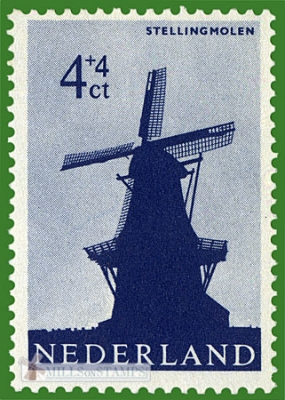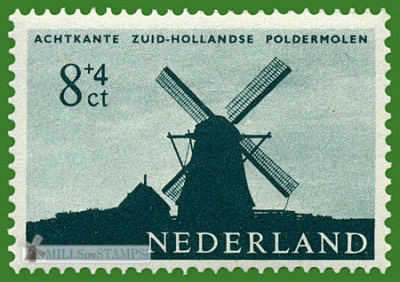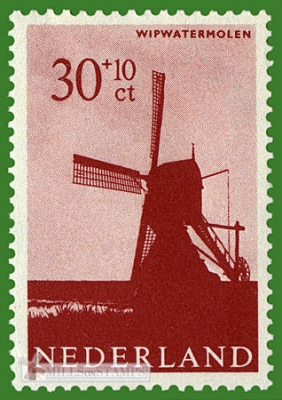-
Windmills. Issue for social and cultural purposes
Netherlands 1963.04.24
In issue: Stamp(s): 5
Printing: lithography
-
Number by catalogue: Michel: 794 Yvert: 769 Scott: B373
Perforation type: 12 ¾x14
Subject:
4+4 cents. Windmill of gallery type* in Limburg**
Additional:
*Gallery type windmill (or tower mill) is a type of windmill which consists of a brick or stone tower, on top of which sits a roof or cap which can be turned to bring the sails into the wind. It is thought to have been invented in Western Europe in the 13th century, a stone windmill being recorded at Dover in 1289. In the Netherlands windmills named torenmolens (tower mills) have a compact-built, cylindric or only slightly conical tower.
In the Southern Netherlands four mills of that type (Dutch definition) survived, the oldest one built in 1441. The cap of three of those mills is turned by a luffing gear built in the cap. Older types of the tower mill could be found on castles, fortresses or city walls with a fixed cap since the 14th century, and are still be found around the Mediterranean Sea. They were built with the sails facing the prevailing wind direction.
**Limburg pronunciation (help·info) (Dutch and Limburgish: (Nederlands) Limburg) is the southern-most of the twelve provinces of the Netherlands. It is located in the southeastern part of the country and bordered by Belgium to the south and part of the west, Germany to the east, the Dutch province of North Brabant partly to the west, and the province of Gelderland to the north. Its capital is Maastricht.
Limburg has a highly distinct character. The social and economic trends which affected the province in recent decades generated a process of change and renewal which has enabled Limburg to transform the drawbacks of its national peripheral location into advantages inherent in its European settings, linking the Netherlands to the southern part of Europe. A less appreciated consequence of this 'international' gateway location however is international crime on the rise, often drugs-related, especially in the southernmost part of this province.Topics: Windmills
-
Number by catalogue: Michel: 795 Yvert: 770 Scott: B374
Perforation type: 12 ¾x14
Subject:
6+4 cents. North Holland polder windmill* in Hazerswoude**
Additional:
*The Netherlands is frequently associated with polders. This is illustrated by the English saying: God created the world, but the Dutch created Holland.
The Dutch have a long history of reclamation of marshes and fenland, resulting in some 3,000 polders nationwide. About half of all polder surface within northwest Europe is located within the Netherlands. The first embankments in Europe were constructed in Roman times. The first polders were constructed in the 11th century. Due to flooding disasters water boards called waterschap (below sealevel) or hoogheemraadschap (above sea level) were set up to maintain the integrity of the water defenses around polders, maintain the waterways inside a polder and control the various water levels inside and outside the polder. Water bodies hold separate elections, levy taxes and function independently from other government bodies. Their function is basically unchanged even currently. As such, they are the oldest democratic institution in the country. The necessary co-operation between all ranks in maintaining polder integrity also gave its name to the Dutch version of third way politics - the Polder Model.**Hazerswoude is a former municipality in the Dutch province of South Holland. It contained the towns of Hazerswoude-Dorp and Hazerswoude-Rijndijk, and the villages Groenendijk and Bent.
Hazerswoude was a separate municipality until 1991, when it became part of Rijneveld -
Number by catalogue: Michel: 796 Yvert: 771 Scott: B375
Perforation type: 14x12 ¾
Subject:
8+4 cents. A South Holland polder mill in Rijpwetering*
Additional:
*Rijpwetering is a town in the Dutch province of South Holland (Zuid-Holland). It is a part of the municipality of Alkemade, and lies about 8 km east of Leiden.
-
Number by catalogue: Michel: 797 Yvert: 772 Scott: B376
Perforation type: 12 ¾x14
Subject:
12+8 cents. Post mill in Limburg
Additional:
*The post mill is the earliest type of European windmill. The defining feature is that the whole body of the mill that houses the machinery is mounted on a single vertical post, around which it can be turned to bring the sails into the wind. The earliest post mills in England are thought to have been built in the 11th and 12th centuries.
The earliest working post mill in England still used today is to be found at Outwood in Surrey. It was built in 1665. The earliest remaining example of a non operational mill can be found in Great Gransden in Cambridgeshire, built in 1612. Their design and usage peaked in the 1700s and 1800s and then declined after the introduction of high-speed steam-driven milling machinery. Many still exist today, primarily to be found in Northern Europe and Great Britain. The term peg mill or peg and post mill (in which the "post" was the tailpole used to turn the mill into the wind) was used in north west England, and stob mill in north east England, to describe mills of this type.
Topics: Windmills
-
Number by catalogue: Michel: 798 Yvert: 773 Scott: B377
Perforation type: 12 ¾x14
Subject:
30+10 cents. Wip mill in Hazerswoude
Topics: Windmills





1963-5s-logo.jpg)
